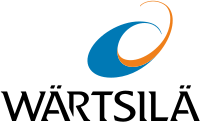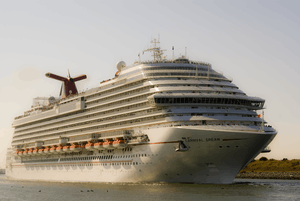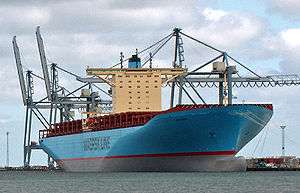Wärtsilä
Wärtsilä Oyj Abp (Finnish: [ˈʋærtsilæ]), trading internationally as Wärtsilä Corporation is a Finnish company which manufactures and services power sources and other equipment in the marine and energy markets. The core products of Wärtsilä include technologies for the energy sector, including gas, multi-fuel, liquid fuel and biofuel power plants and energy storage systems;[2] and technologies for the marine sector, including cruise ships, ferries, fishing vessels, merchant ships, navy ships, special vessels, tugs, yachts and offshore vessels. Ship design capabilities include ferries, tugs, and vessels for the fishing, merchant, offshore and special segments.[3] Services offerings include online services, underwater services, turbocharger services, and also services for the marine, energy, and oil and gas markets.[4] At the end of June 2018, the company employed more than 19,000 workers.[5]
 | |
| Julkinen osakeyhtiö | |
| Traded as | Nasdaq Helsinki: WRT1V |
| ISIN | FI0009003727 |
| Industry | Manufacturing and service |
| Founded | 12 April 1834 |
| Headquarters | Helsinki, Finland |
Key people | |
| Products | Power plants, marine propulsion systems, maintenance services |
| Revenue | |
| Total assets | |
| Total equity | |
Number of employees | |
| Website | www |
Wärtsilä has two main businesses; Energy Business focusing on the energy market, and Marine Business focusing on the marine market. The Marine Business is mainly present in Europe, China and East Asia, while its key Energy Business markets are South and South East Asia, the Middle East, Africa and Latin America. Wärtsilä has locations in around 80 countries but operates globally.[6]
The company has signaled its intention to transform from an equipment maker to a smart marine and energy company, following acquisitions of companies such as Transas, Greensmith, Guidance Marine, and MSI, and the setting-up of ′digital acceleration centres′ in Helsinki, Singapore, Central Europe, and North America.
History
Origins
Wärtsilä was established when the governor of the county of North Karelia approved the construction of a sawmill in the municipality of Tohmajärvi, Finland on 12 April 1834. The sawmill was soon taken over by industrialist Nils Ludvig Arppe, who built ironworks in the premises. In 1898 the company was renamed Wärtsilä Ab.
Diesel engines
In 1938 the diesel engine era began when Wärtsilä signed a licence agreement with Friedrich Krupp Germania Werft AG in Germany. The first diesel engine was produced in Turku, Finland in November 1942. During the following decades more focus was put on manufacturing diesel and gas engines with the acquisitions of the Swedish firm NOHAB in 1978, the French Société Alsacienne de Constructions Mécaniques (SACM), and the Dutch Stork-Werkspoor in 1989.
In 1997 Wärtsilä absorbed the diesel motor producing New Sulzer Diesel (NSD), which had been created by Sulzer in 1990.
Hybrid Engines
In 2020, Wärtsilä made plans to supply hybrid engine solutions for the ultra environmentally friendly Finnlines[7]
Expanding portfolio
Through acquisitions of marine propulsion systems supplier John Crane-Lips in 2002, marine automation company Total Automation in 2006, specialist equipment company Hamworthy in 2012 and L-3 Marine Systems International in 2014, Wärtsilä expanded their portfolio considerably.
Marine market
The company services the merchant, offshore, cruise and ferry, naval, fishing, tugs, yachts and special vessel markets, and the offering includes ship design, main and auxiliary engines, auxiliary power systems, electrical and automation packages, propulsors (such as water jets, thrusters, propellers, and nozzles), seals, bearings, gears, rudders, scrubbers, boilers, and all related services, such as repair, configuration, upgrading, training, maintenance, and environmental services.
Customers comprise both shipyards and ship owners. The environmental products range from reduction of air emissions, such as NOx, SOx, CO, and volatile organic compounds (VOCs), to oily waste water treatment and other water systems such as ballast water management systems.
Wärtsilä Marine was an important Finnish shipbuilder from 1935 until 1989, building cruiseferries, cruise ships and a large share of the icebreakers of the world. The former Wärtsilä Marine Turku Shipyard is now owned by Meyer Werft under its Meyer Turku subsidiary and the Helsinki shipyard is operated by Arctech.
Energy market
Wärtsilä is a provider of power plants in distributed and flexible power generation. The product portfolio consists of installations up to 600 MW, running on any gaseous or liquid fuels, such as Heavy fuel oil, natural gas, liquefied natural gas (LNG), different types and qualities of fuel oils, and renewable fuels like biogas and biofuel. In addition for the reliability of traditional base power generation, the engines have the capability to start and stop quickly and they maintain their efficiency in part load, which makes them well suited for peaking power production, smart grids, and emergency power systems. They can also utilize the combined cycle and cogeneration to produce steam or hot water for heating, and trigeneration for chilled water, which can be used for air conditioning.
Wärtsilä also provides products and services for grid stability management, utilization of gas flares, pumping applications (such as pump and compression drives), financial services, and project management services for projects concerning power generation.
In May 2017, Wärtsilä signed an agreement to acquire Greensmith Energy Management Systems Inc.[8]
In March 2018, the company announced that it had delivered the world's largest solar hybrid power plant], situated in Burkina Faso.[9]
Wärtsilä provides about 25 percent of Bangladesh's total grid capacity, with the company's total power supply to Bangladesh rising to more than 4200 MW when a 105MW power plant being built by Baraka Shikalbaha Power Ltd goes fully operational in spring 2019.[10]
Wärtsilä's wide energy products and systems footprint includes the US, Germany, the UK, China, Russia, Singapore, Bangladesh, India, Indonesia, Myanmar, Senegal, the Dominican Republic, Australia, Saudi Arabia, Tanzania, Morocco, Argentina, Sierra Leone, Brazil, Finland, Mauritius, Rwanda, Honduras, El Salvador, Kazakhstan, Mexico, Jordan and Oman.
Services market
The wholly owned service network consist of over 4,500 field services professionals in more than 160 locations in over 70 countries globally, with the installed base of over 180 000 MW. The focus lies on optimising operations and life cycle performance of land based power plants and ship installations.[11]
Wärtsilä provides services, spare parts, maintenance, upgrades, and fuel conversions products for medium and low-speed gas and diesel engines and other related systems, propulsion systems, electrical & automation systems, boilers including environmental solutions regarding particulates and NOx, covering scrubber, selective catalytic reduction (SCRs), oxidation catalysts,[12] ballast water treatment systems and oily-water systems, long-term service agreements, training, condition monitoring, and condition-based maintenance and advisory services.
In January 2017, Wärtsilä and Carnival Corporation announced a 12-year performance-based agreement worth 900 million euros.[13]

Acquisitions in the Services business include Eniram in 2016, Trident B.V in 2017, and Lock-N-Stich.
On October 1, 2018 Wärtsilä announced that it would reorganize into two business areas, incorporating the Services business into the existing Marine and Energy businesses.[14]
Market share and competitors
At the end of 2017, Wärtsilä's market share in marine medium-speed main engines was 47% and in auxiliary engines 10%. Wärtsilä's market share for gas and liquid fuel power plants was 19%.[15]
Wärtsilä's biggest competitors in the marine market are MAN Diesel & Turbo, Caterpillar Inc. and Rolls-Royce plc. and in the energy market the biggest competitors are mainly gas turbine manufacturers like General Electric and Siemens.
Engines

Wärtsilä produces a wide range of medium-speed diesel, gas and dual- and multi-fuel engines for marine propulsion, electricity generation on board ships and for land-based power stations.
A joint venture agreement between Wärtsilä and China State Shipbuilding Corporation (CSSC) for the take-over of Wärtsilä's 2-stroke engine business was announced in July 2014 and finalized in January 2015.[16]
The engine models are generally identified by the cylinder bore diameter in centimeters, which as of 2012 range from 20 to 64 centimetres (7.9 to 25.2 inches) for medium-speed and 35 to 96 centimetres (14 to 38 inches) for low-speed engines. The smallest engine series, four-stroke medium-speed Wärtsilä 20, produces a modest 200 kW (270 hp) per cylinder while the largest, two-stroke low-speed Wärtsilä RT-flex96C, has a maximum output of 5,720 kW (7,670 hp) per cylinder. In addition, Wärtsilä also produces the most powerful medium-speed engine series in the world, Wärtsilä 64, with an output of 2,150 kW (2,880 hp) per cylinder. Depending on the engine model, Wärtsilä offers medium-speed engines in both straight and V configurations with the number of cylinders ranging from four (4L20) to twenty (20V46F), and low-speed engines in inline configuration with five (5RT-flex35) to fourteen cylinders (14RT-flex96C). The most powerful low-speed engine ever produced by Wärtsilä, a 14-cylinder version of the RT-flex96C, produces 80,080 kW (107,390 hp) and is used to propel the Mærsk E-class container ships.
In 2015, the Wärtsilä 31 engine achieved a Guinness World Records title for the most efficient 4-stroke diesel engine.[17]
Wärtsilä revealed manipulation of fuel consumption tests after an internal audit in 2016, with a few hundred engines affected.[18][19] According to the company, the customer impact of the deviations was marginal.
Key figures
Key figures of Jan-Dec 2018:[20]
- Order intake – EUR 6307 million (5644)
- Order book – EUR 6166 million (5100)
- Net sales – EUR 5174 million (4911)
- Operating result – EUR 577 million (576), 11.2% of net sales (11.7%)
- Earnings per share – 0.65 euro (0.63)
- Cash flow from operating activities EUR 470 million (430)
All numbers are shown excluding non-recurring items and selling profits.
See also
- Finnish maritime cluster
- Värtsilä
References
- "Financial information". Wärtsilä. Retrieved 6 May 2020.
- "Power Generation Solutions". www.wartsila.com. Retrieved 2018-09-26.
- "Areas of Expertise - Your shorter route to bigger profits". www.wartsila.com. Retrieved 2018-09-26.
- "Areas of Expertise - Wärtsilä Services". www.wartsila.com. Retrieved 2018-09-26.
- "Half year financial report January-June 2018" (PDF).
- "Wärtsilä Global Address Book". 2017-06-21.
- "Wärtsilä to supply hybrid solutions for ultra-green Finnlines RO/RO duo". www.wartsila.com. Retrieved 2020-02-17.
- "Wärtsilä acquires Greensmith Energy Management Systems Inc. to position itself as a global energy systems integrator". www.wartsila.com. 15 May 2017. Retrieved 27 September 2018.
- "Wärtsilä delivers world's largest solar hybrid power plant, reducing annual CO2 emissions by as much as 18,500 tons". wartsila.com.
- "Wärtsilä signs contract for another 105 MW power plant in Bangladesh". wartsila.com.
- Wartsila Corporate presentation, 2012. Retrieved 12 March 2013.
- Wärtsilä Low NOx Solutions Archived September 29, 2015, at the Wayback Machine Wärtsilä, 2008
- "Wärtsilä and Carnival Corporation announce strategic performance-based partnership". www.wartsila.com. 25 January 2017.
- "Wärtsilä redesigns organisation to enhance customer value". steelguru.com.
- "Market shares". wartsila.com.
- take-over of Wärtsilä’s 2-stroke engine business, wartsila.com
- most efficient 4-stroke diesel engine, wartsila.com
- "Finsk koncern erkänner fusk med båtmotorer".
- "UPDATE 1-Finland's Wartsila admits manipulation of ship engine fuel tests". Reuters. 2017-03-07. Retrieved 2016-10-26.
- "Financial Statement bulletin January-December 2018". Wärtsilä. Retrieved 26 July 2019.